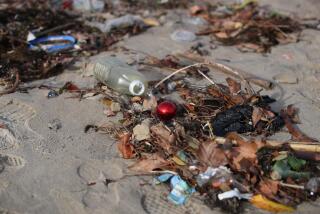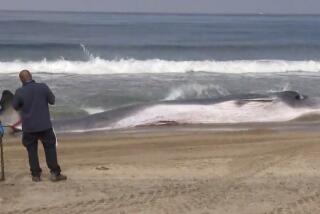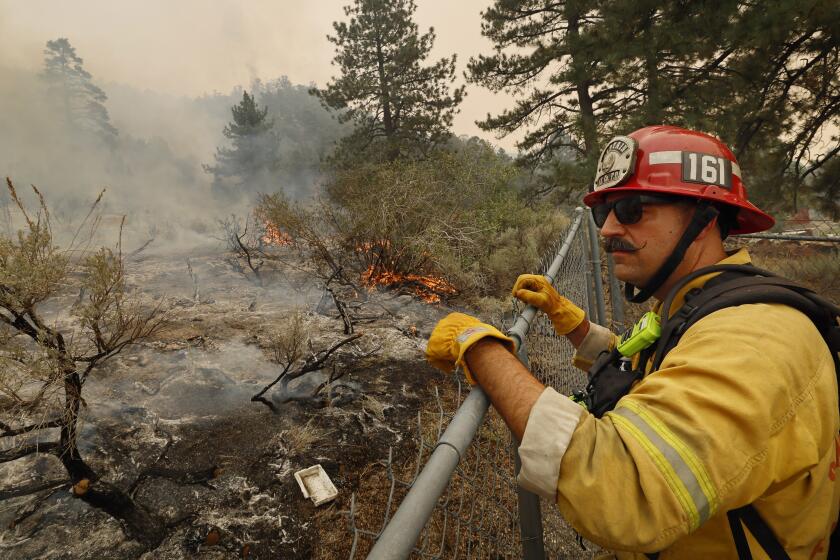Column: My close encounter with a shark got me out of the water — but not for long
It was not a dolphin, that much I knew. The fin skimmed the surface of the water like a razor blade, unlike the lolling rise and fall of a dolphin’s fin.
It was not a figment of my imagination, either. I know that because my 14-year-old daughter saw the same thing I did as we waited, with our body boards, for the next good wave to roll in.
We were in waist-deep, blue-green surf at Padaro Beach, the sweet little stretch of paradise you can see from Highway 101 at Santa Claus Lane. It was late morning on Sunday, a gray, cool day, with surprisingly warm water.
Spooked, but exhilarated
“That’s a shark,” I said, stating the obvious to my daughter as we both walked backwards toward the sand, eyes fixed on the fin about 40 or 50 feet away. “Let’s get out.”
I was a little spooked, sure, but it was also exhilarating. I grew up swimming at California beaches and have always been mesmerized by the beauty, wonder and mystery of the coast, but I’d never had such an experience.
Three kids were in the water just up the beach, where the shark was headed, so I yelled for them to get out. Then several adults gathered at the water’s edge to talk about what has been, in Southern California, another fin-filled summer.
Last year, when I toured the entire California coast while covering the agency whose duty is to protect it, the Santa Cruz-area beach I enjoyed as a kid was closed because of shark sightings. And then the main beach in Carpinteria was closed for the same reason just a day after I swam there with my wife and daughter.
So should we have retired the boogie boards on Sunday, even though based on the fin size, the shark we saw was probably young and no more than 6 feet long?
A day earlier, I’d bumped into Chris Keet on the same beach. He runs the Surf Happens camp where I first learned to surf, and I asked how it was going. He said business was good, but he and his instructors had spotted sharks nearly every day. They usually came in at low tide to feed on stingrays, he said, and the sharks were mostly between 6 and 8 feet, with at least one closer to 10 feet or so.
Keet said his crew goes out on paddle boards to make sure the area is safe, and he uses a whistle to call students out of the water when sharks are in the vicinity. To the south is a harbor seal rookery that has been known to draw bigger great whites looking for a nice meal, so Keet takes extra precaution if he sees a seal in the water.
Respect and caution
The sharks he’s spotted have been nonaggressive, don’t seem interested in people, and have not attacked. Keet said he explains all this to parents, some of whom get nervous, but most of whom are comfortable enough to turn their kids over to him.
“If you proceed with caution and respect, I think most people are going to be fine,” said Keet.
That sounded reasonable to me. I’m not brave enough to paddle straight out, 300 yards from shore, but I grew up swimming on the California coast, and it’s not something I want to give up. Besides, the growing shark population signals a healthy ecosystem, and that’s something to celebrate rather than fear.
So my daughter and I, along with other people on the beach, went back into the water Sunday, stayed just waist-deep, and kept our eyes open.
Was I an irresponsible dad for doing that in the middle of a summer in which TV news coverage of great whites has been more prevalent than car chases?
I called Chris Lowe, the marine biologist who heads up research at Cal State Long Beach’s Shark Lab, and told him about my experience in Carpinteria.
“You’ve just described the new reality,” he said.
Lowe said some have argued that we don’t have more sharks, we simply have more people with paddle boards, drones and access to social media.
“But … we actually do have more sharks,” he said.
That’s because of 1994 restrictions on the fishing of great whites, and because environmental protections of waterways have replenished both the shark population and the animals sharks feed on, namely seals and sea lions, stingray, guitarfish, halibut and other animals.
Nurseries for juvenile sharks
By the way, it’s not sharks Lowe fears, but the sharp teeth of the nation’s current crop of big tuna, who are inclined to shred environmental protection and snip funding for critical scientific research. Lowe has been tagging, monitoring and studying sharks for years, and his work was featured on a recent Discovery Channel Shark Week episode called “Sharks in the City: Los Angeles.”
He said several locations — Ventura to Carpinteria, Santa Monica Bay, Huntington Beach and between Dana Point and San Onofre — have become nurseries for juvenile sharks. Two or three years ago, video surveillance of the stretch between the Manhattan Beach and Hermosa Beach piers showed the routine presence of up to 14 great white sharks about 5 or 6 feet long, said Lowe.
They feel safe close to the shore, where food is plentiful and there’s no threat of larger sharks coming after them, and the warm water of the last few years seems to suit them. When they’re older and bigger, they head toward the Channel Islands and feed on the exploding population of seals.
So we’re pretty safe, Lowe said, but we are literally swimming with sharks — lots of them — as part of the new norm, and you have to respect them and their environment.
Lowe doesn’t put much stock in the theory that sharks feed at dawn and dusk or that those times are riskier for swimmers. I told him I had a small cut on my wrist when we saw the shark on Sunday and wondered whether a trace of blood would have raised the risk for me. Lowe said he has dumped gallons of blood into the water and seen no evidence that it makes sharks hungrier or more inclined to follow the scent.
Popular beaches can be safer than quiet ones, Lowe said, because crowds of people are loud and their presence scares away the food sharks are fishing for.
Lots of sightings, few attacks
Internationally, he said, although the number of people in the water is greater than ever, shark attacks on humans are up only slightly, and fatalities are down a bit because of better emergency response and treatment.
Still, naturally, everyone’s attention is riveted on occasion, such as when that woman was severely injured by a shark attack off Camp Pendleton this spring. Two weeks ago, sharks attacked a kayaker and paddle boarder off Santa Barbara, although no one was injured.
But Lowe puts all this in perspective. For all the shark sightings and beach closures the last two years, attacks on humans have been rare.
Lowe said he wouldn’t frolic in the surf off the Channel Islands, but he wouldn’t discourage anyone from enjoying the coast as long as they assess the risks and use their heads.
“The chance of being run over by a car in the parking lot,” he said, “far exceeds the risk of being bitten by a shark.”
There’s plenty of summer left, so get your flip-flops and your boards, head to the beach, and keep your eyes open.
Get more of Steve Lopez’s work and follow him on Twitter @LATstevelopez
ALSO
Round 2: Monsoonal moisture to bring more wild weather and thunderstorms to Southern California
High-water year makes Pacific Crest Trail a more treacherous hike
China’s Gobi Desert feeds Yosemite National Park’s forest, study says
More to Read
Sign up for Essential California
The most important California stories and recommendations in your inbox every morning.
You may occasionally receive promotional content from the Los Angeles Times.











